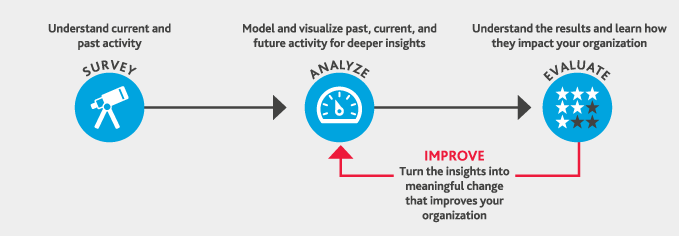4 Steps to Implement Predictive Analytics
It’s crunch time for year-end giving. Many nonprofits use this time of year as an opportunity to pilot new fundraising tactics and experiment with new technology to target donors. In part one of this series, we introduce predictive analytics, which has the potential to optimize the effectiveness of giving campaigns and improve nonprofits’ processes.
If your current fundraising activities are falling short of your goals or you’re facing new competition for donors, now could be the perfect time to dip your toes into predictive analytics. To help you get started, this blog takes a comprehensive look at the mechanics.
HOW DOES PREDICTIVE ANALYTICS WORK?
In the traditional fundraising process, several steps are typically employed across different layers of a nonprofit’s data. First, key donors are identified and targeted. This may be done based on selecting key individual donors, by a prior donation level threshold, and/or demographic information. Next, past campaigns are assessed, and new campaigns may be discussed and evaluated. Finally, a plan is developed and executed to drive fundraising. For this entire process, the rigor of data analysis and the evaluation of past campaign effectiveness may vary by organization but, at a high level, the processes are similar: organizations make use of data and personal judgment to drive future fundraising efforts.
The predictive analytics process runs alongside this methodology to augment it, which acts as an advisor to existing activities and decision-making processes. Predictive analytics offers a way to look at the information in a new way by incorporating your existing methods and institutional knowledge. Predictive analytics can be run parallel to your process to offer new ideas, prove or disprove existing ideas and approaches, and provide a way to gauge how effective new approaches to fundraising will be.
The core steps include:
-
Identify the organization’s goals and survey historical data to map the goals to key data points. In this step, the organization determines which questions it wants answered and whether the data it needs is available.
-
Develop a predictive model and analyze and visualize the data to derive insights. This step allows nonprofits to derive forward-looking analyses and findings from historical data. Specialized software and/or custom-developed logic in a programming language, such as Python or R, is used for the analysis.
-
Evaluate the results to determine whether the analysis was effective and, if so, how to apply the findings for meaningful actions.
-
Finally, an iterative process of refining and re-running the analysis is performed based on the findings and changes.
These steps are outlined below:

A major misconception about predictive analytics is that it can replace a fundraising team or will serve as a stand-alone fundraising strategy function. A predictive analytic model is only as effective as the information and guidance that is provided to it, and performing predictive analytics effectively requires institutional knowledge and refinement. Predictive analytics is a statistical and technological way to utilize data based on institutional knowledge, so it is useful only if it is designed, implemented and evaluated by data and industry experts.
WHEN IS THE RIGHT TIME TO PILOT PREDICTIVE ANALYTICS?
Many nonprofits choose to implement predictive analytics when the board or executive leadership team recognizes that its fundraising efforts could be improved. At that stage, an organization may have sufficient data to understand what worked well in the past, but it would likely rely on comparisons between past approaches and new approaches, market research and small test campaigns to evaluate new ways to raise funds. Nonprofit leaders may choose to engage a data scientist team or purchase a predictive analytics package if current fundraising techniques and test ideas—which require an investment of time and resources—aren’t delivering the desired results.
Predictive analytics is an important method for improving your fundraising process. Just as major retailers, financial institutions and healthcare companies are utilizing predictive analytics to maximize revenue and reduce costs, nonprofits have an opportunity to make use of this technology within their own organizations. Regardless of the volume of fundraising you are doing or the makeup of your donors, you can benefit from applying predictive analytics.
Be sure to keep up with the latest happenings in the nonprofit industry by subscribing to our blog, and following us on Twitter @BDONonprofit.
SHARE